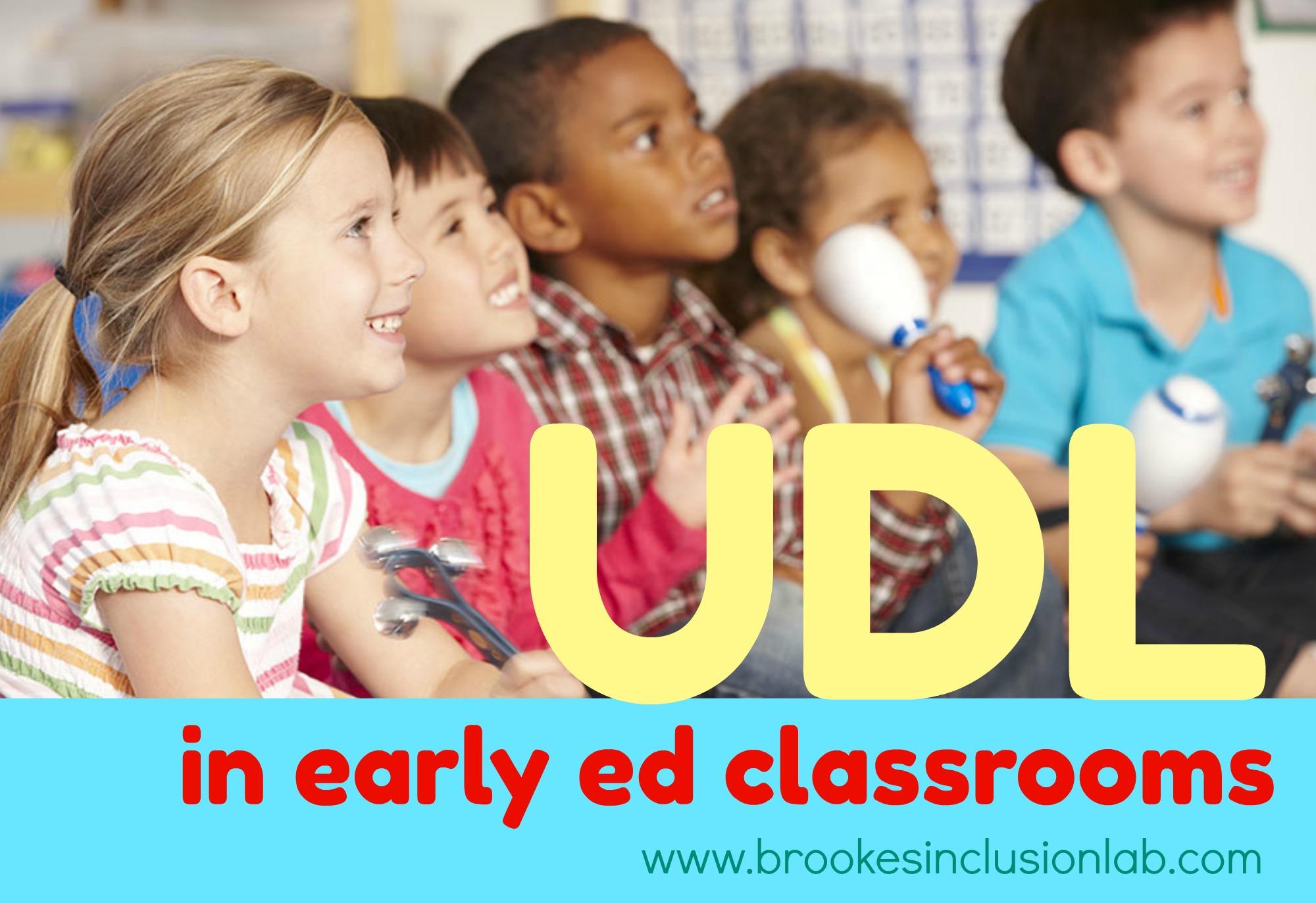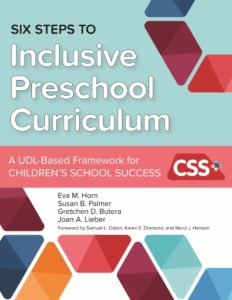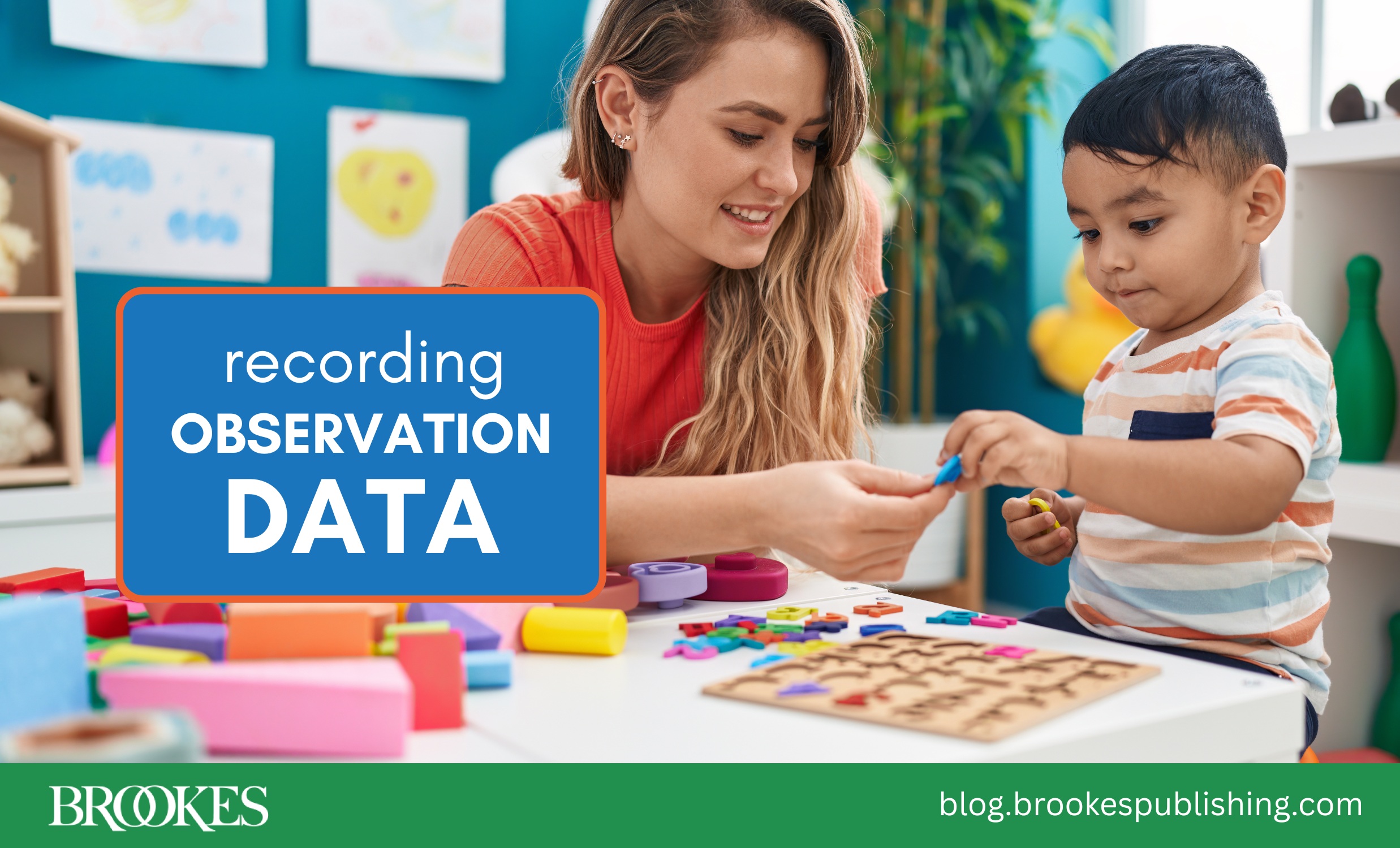Enhancing Early Ed Classrooms with UDL
January 30, 2018
 On the Brookes blog, we bring you lots of practical posts about enhancing K-12 classrooms with universal design for learning (UDL). But does UDL work equally well in early childhood settings? Yes—and today’s post gives you some simple starting points to help all young children be successful and meet learning standards. It’s excerpted and adapted from Six Steps to Inclusive Preschool Curriculum (Eva M. Horn et al.), a practical book on building a UDL-based plan for inclusive preschool instruction.
On the Brookes blog, we bring you lots of practical posts about enhancing K-12 classrooms with universal design for learning (UDL). But does UDL work equally well in early childhood settings? Yes—and today’s post gives you some simple starting points to help all young children be successful and meet learning standards. It’s excerpted and adapted from Six Steps to Inclusive Preschool Curriculum (Eva M. Horn et al.), a practical book on building a UDL-based plan for inclusive preschool instruction.
You may already know the three primary principles of UDL (as identified by CAST, the nonprofit education research and development organization that works to raise awareness and use of UDL):
1) Multiple means of representation to give learners a variety of ways to gain access to information and content
2) Multiple means of engagement to gain and maintain learner interest
3) Multiple means of action & expression to provide learners with a variety of ways for demonstrating what they know
Today we’ll briefly take you through all three of these principles and give you some quick tips on how to put them into action in an early childhood setting.
Means of Representation
Young learners all process information differently. Some will understand and retain it better by seeing it, some by hearing it, some by touching it—and others will learn best using a combination of means. Reach all your learners by providing two critical things: multiple forms of communication and multiple levels of complexity.
Providing Multiple Forms for Communication
Support all your students by providing information in multiple ways, using auditory, visual, and tactile formats. When you provide directions or instruction for completing an activity or task, communicate the information by
- Verbally stating the information
- Providing a picture or other visual model of the steps in the task
- Presenting the actual tools/materials students will use to complete the task
Providing for Multiple Levels of Complexity
Children come to your classroom with a broad range of prior experiences and knowledge. Some may need very concrete information to understand new tasks, while others may be able to process explanations that use more complex concepts. Take this into account when you give students instructions and introduce an activity, and deliver the information in ways that reflect multiple levels of complexity.
- Model the steps for completing a task while verbally describing them.
- Read a phrase with a key vocabulary word in a storybook and then stop and show a vocabulary picture card, state the word, and define it.
- Repeat and restate key concepts in different ways so that all students understand.
- Break instructions into discrete steps: “First, select the color of paper for your name card. Second, select the first letter of your name from the letters on the table. Third, glue the letter on the first space on the name card.”
Means of Engagement
Young children vary greatly in what captures their attention and motivates them to engage and learn. To get children hooked and keep them focused on your lessons, provide multiple means of engagement for them. The concept of engagement can be divided into two big ideas: recruiting children’s interest and sustaining their attention and persistence to a task. Here are some practical tips and strategies for both:
Recruiting Children’s Interest
- Observe young learners at work. Build on your knowledge of the types of activities and materials that intrigue young learners by observing and listening to same-age children in natural play environments.
- Think about learners as individuals. Consider the variety of factors that influence child interests, including gender, temperament, life experiences, and family culture as well as the current popular themes, characters, and toys.
- Respect differences. Choose materials and activities that reflect responsiveness to children’s differences while communicating that the classroom is a place to freely explore.
- Give children choices. Something as simple as allowing the children to choose where they will sit as a small group can entice the children to join the storybook reading group.
- Make meaningful connections to children’s prior experiences and current environments. For example, as children explore the characteristics of rocks, connect the discussion to the children’s prior experiences by asking questions: Who likes to collect rocks? What kinds of rocks are your favorite?
- Provide a balance between the novel and the familiar. In the rock-exploring activity, for example, you might include an ice cube to add some novelty, which could spark a discussion on changes in size, weight, and solidness as the ice melts.
Sustaining Children’s Attention
- Keep an eye on difficulty levels–ensure that that children are challenged by activities and tasks but not bored or frustrated.
- Set them up for success. Provide some experiences in which you know your learners will be successful. This will encourage them to continue.
- Support children’s persistence with other experiences that are just beyond their mastery. Give them appropriate levels of feedback, encouragement, and scaffolding so they can complete these tasks and learn new things.
- Vary groupings. Use large groups, small groups, and independent time strategically, to complement the content you’re teaching. For example, small-group instruction may be better for introducing new skills and concepts.
- Implement proven strategies that are known to be effective in preventing wandering attention and supporting children’s persistence.
- Don’t make activities too long. Pay close attention to the length of your activities and alternate between active participation and more quiet observation.
Means of Expression
How can you help children organize what they know and then show what they’ve learned? Every child has different abilities and comfort levels, so it’s important to let them express what they’ve learned in a variety of ways and formats. You can address the UDL principle of means of expression by considering two key aspects—multiple acceptable formats for making responses and multiple acceptable levels of complexity of responding.
Multiple Acceptable Formats for Making Responses
Every learner approaches a lesson differently, so make sure that your activity plans provide multiple options for responding to your questions. These might include verbal responses, gestures, drawing, finger plays, songs, and writing.
Here’s a simple example: Say you’re reading a storybook to your students. You ask them questions about an object shown on one of the pages—let’s say it’s a truck. Give children multiple options for responding to your questions; for example, children might reply by:
- Pointing to the truck
- Naming the truck
- Holding up a matching picture card of a truck
- Holding up a real object match (e.g., a small toy version of a truck)
Children who use augmentative and alternative communication may also respond by using their communication board.
Multiple Acceptable Levels of Complexity of Responding
Allow for various levels of complexity and length in your learners’ responses, to reflect and respect their different preferences, strengths, and abilities. Here’s an example: Say you’re reading a storybook about zoo animals to your class, and you ask the children what they see on the page. Children’s answers will vary in complexity:
- One child may be able to provide a basic, one-word response, such as “monkeys.”
- Another may answer the question in a multiple-word sentence (e.g., “The monkey is eating bananas.”)
- Another child may add new information that connects to their own experience (e.g., “I like bananas too. I eat them at breakfast.”)
For children who need extra support in sharing their understanding and expressing ideas, think about what kind of scaffolding you can use during your lesson or activity. For example, if you ask how many apple slices are on the table as children prepare a snack, some children will be able to independently answer your question, while others will need support. You might encourage the whole group to count the apples together so the children who need support can follow along and strengthen their skills. If a child needs more support with counting, you might try prompting the child by providing the initial sound of each number.
***
This post gave you some quick tips to use as a UDL launching pad in your early childhood classroom. For more information, visit the CAST website (a treasure trove of professional learning opportunities and resources) and explore the other UDL posts on the Brookes blog.
CHECK OUT THE BOOK
 Check out Six Steps to Inclusive Preschool Curriculum by Eva M. Horn, Ph.D., Susan B. Palmer, Ph.D., Gretchen D. Butera, Ph.D., & Joan A. Lieber, Ph.D., with invited contributors. Through practical, evidence-based strategies and guidelines, you’ll discover how to equalize access to preschool curriculum content while giving young learners multiple ways to access and process new knowledge.
Check out Six Steps to Inclusive Preschool Curriculum by Eva M. Horn, Ph.D., Susan B. Palmer, Ph.D., Gretchen D. Butera, Ph.D., & Joan A. Lieber, Ph.D., with invited contributors. Through practical, evidence-based strategies and guidelines, you’ll discover how to equalize access to preschool curriculum content while giving young learners multiple ways to access and process new knowledge.




Write a Comment
Your email address will not be published. Required fields are marked *
Post a Comment